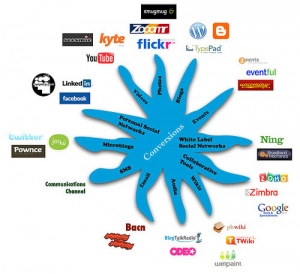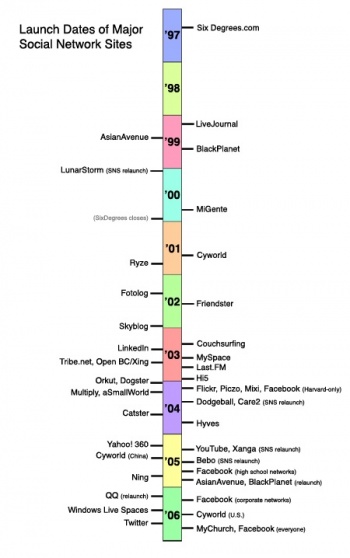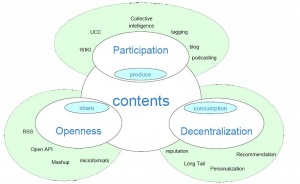Social network service
From Computing and Software Wiki
SNS (Social Network Service) is the application service that helps people builds online social communities where they share interests and/or activities. Most SNSs are web based to provide a variety of ways for users to communicate or interact, such as social network websites, e-mail, SMS (short message service), and blogs.
List of Social networking websites
Contents |
What is social network service
Social network service, also known as "Social networking service/sites", it refers to a wide-range of rapidly developing services tools and practices. Social network services can be broadly defined as Internet- or mobile-device-based social spaces designed to facilitate communication, collaboration and content sharing across networks of contacts. SNSs allow people to build and manage their social networks online. These services usually include other individuals, and might also include the profiles of events, groups, companies, or even political parties. SNSs typically support the public display of networks, however, permission is a very important feature of most SNSs nowadays. They allow users to restrict the accessibility of their profiles, information, and connections, as well as the degrees of access, therefore, providing certain level of privacy and protection over public online communities. Most social networking sites have three common elements/functionalities: a member profile, the ability to add other members to a contact list, and supported interaction between members of contact lists.[1][2]
Types of social network services
Profile-based social networking services
The essential part of Profile-based services are users' profile pages - pages that contains information about each user, usually including the person's pictures, hobbies, life experiences, etc. MySpace, Bebo, and Facebook are typical examples of profile-based services. This type of service provides functionalities like message walls, daily logs or picture editing to help users to develop their own spaces, and to contribute to each other's space. It facilitates the user interactions over Internet.
Content-based social networking services
In these services, posting of content is playing the major role in order to organize the connections among users, but user's profile still remains an important role here. Flickr and Youtube are all good examples of this type of services.
White-label social networking services
Another essential functionality of SNS is group-building, white-label SNS provides user the opportunity to create and join communities, they can create their own small-scale, personalized social networking sites that support certain interests, events or activities, they can also join others' community. Website like Ning is such type of service.
Multi-user virtual environments
Most online games such as World of Warcraft and Second Life allows users to interact with each other virtually. The individual profiles are the characters they created and customized, and friends lists are not public or shared.
Mobile social networking services
Sites such as MySpace and Twitter provides their services not only over internet, but also through mobile phone, they allow users to communicate with friends via cell phones, and most essential features are usually provided.
The basic concept of "Six-degree of separation"
The idea of SNS is based on the concept of “Six degrees of separation” which introduced by Stanley Milgram, the social psychologist at Harvard University. Simply say that “if a person is one step away from each person they know and two steps away from each person who is known by one of the people they know, then everyone is at most six steps away from any other person on Earth.”[2]
History of SNS
The early years, SNSs were in the form of generalized online communities where people interact with each other through chat rooms, and later on, some websites focused on ties with friends by linking people together via email address. The first recognizable social network site "SixDegrees.com" launched in 1997, it focused on indirect ties, it combined all the former features with its new features, it allowed people to create profiles, list their friends, surf the friends list, and surf the network that connects people in the same school or with similar interests together. However, while the website attracted lots of users by these new features, it failed to become a profitable business and was shut down in 2000, even the owner believes that it was simply ahead of time.[3] As time goes by, the launching of Ryze.com helped people leverage their business networks, but it never acquired mass popularity. In 2002, Friendster as one of the three most popular SNSs has been launched, unlike the usual online dating sites, Friendster was designed to help friends-of-friends meet, which is based on the assumption that would make better romantic partners than would strangers, but many early users left later on due to technical and social difficulties that the site encountered. Between 2003 to 2007, more and more SNSs emerged, which made the SNS hit the mainstream, such as MySpace, Bebo, and Facebook, they all grew rapidly. MySpace was reportedly getting more page views than Google. In 2006, Facebook opened up to the college communities outside US, plus allowing add-on applications that developed externally, it became the largest and fastest growing site in the world.
Pros and Cons of SNS
Pros
- SNSs can have a positive effect for easier communication to your friends, family, or colleagues. Students could discuss school work by having a conference in a certain site instead of meeting in a certain place, therefore saving time and effort.
- Computer-Mediated Communication allows people to find or reconnect with friends from the past whom they may have lost contact with.
- Literally saying that, the number of people that you can meet or connect with is unlimited on SNS sites.
Cons
- Since social network service commonly use online profile to establish connections and meet friends, they have also become likely places for personal identity theft and fraud. As people have to provide certain infromation such as name, address, phone number and contact information, and these information will always be there as long as the users are still using the service, so others may use these important information and pretend the person who provides those information to do some illegal activities.
- Social networking sites could be addictive for the young and old. There are usually instant messaging features as well as video and picture features so that everyone on your network can keep up to date with what you are doing. These sites come equipped with various accessories and add-on applications to make your time online not so much productive, but fun.[4]
Web 2.0 and Social network service
Web 2.0 is a term coined by Tim O'Reilly. It redefines the interactions between Internet and users and brings about a new Internet ecosystem, the framework of it hinges on Participation, Openness and Decentralization. The concepts of Web 2.0 have led to the developement and evolution of web-based communities, hosted services, and applications[5], therefore SNS is the service or application site of Social Network that applying the concepts of Web 2.0. It is in people's instinctive nature to connect with each other, SNS creates a big and lasting market for community services, and the convergence brings about multiple channels and platforms for facilitation of social network (not to be confused with SNS).
Milestones of Social network service
• “Concept of six-degree of separation” was
introduced in 1995
• Friendster launched and became popular
• The Tim O’ Reilly coined term, Web2.0, becoming
popular from 2003/2004
• Cyworld Korea became popular in 2003 and
became Product of the Year in 2004
• Cyworld launched in China, Japan, US, Taiwan
and Vietnam in 2005 and 2006
• Acquisition of Myspace by Newscorp (2006)
• Mixi listed in Japan (Aug 2006) with
over US$1 Billion market cap
• Yahoo acquisition discussion with Facebook
(2006)
• Another UGC(User Generated Content) megadeal: Google acquired
YouTube (Oct 2006)
See also
References
1. Fraser, on behalf of Childnet International, "Young People and Social Networking Services", digzen.org, http://www.digizen.org/socialnetworking/default.aspx
2. (Boyd & Ellison, 2007, p.3)
3. Wikipedia contributors, "Six degrees of separation," Wikipedia, The Free Encyclopedia, http://en.wikipedia.org/w/index.php?title=Six_degrees_of_separation&oldid=282380925 (accessed April 8, 2009).
4. Star-Publishing, "Social Networking Websites: the Good, the Bad, the Ugly", http://stluciastar.com/content/?p=2652
5. Wikipedia contributors, "Web 2.0," Wikipedia, The Free Encyclopedia, http://en.wikipedia.org/w/index.php?title=Web_2.0&oldid=282443635 (accessed April 8, 2009).
External links
- UGC
- social network
- User Profile
- Social network aggregation
- Online dating service
- Mobile social network
- Virtual community
--Shensw 12:46, 9 April 2009 (EDT)



